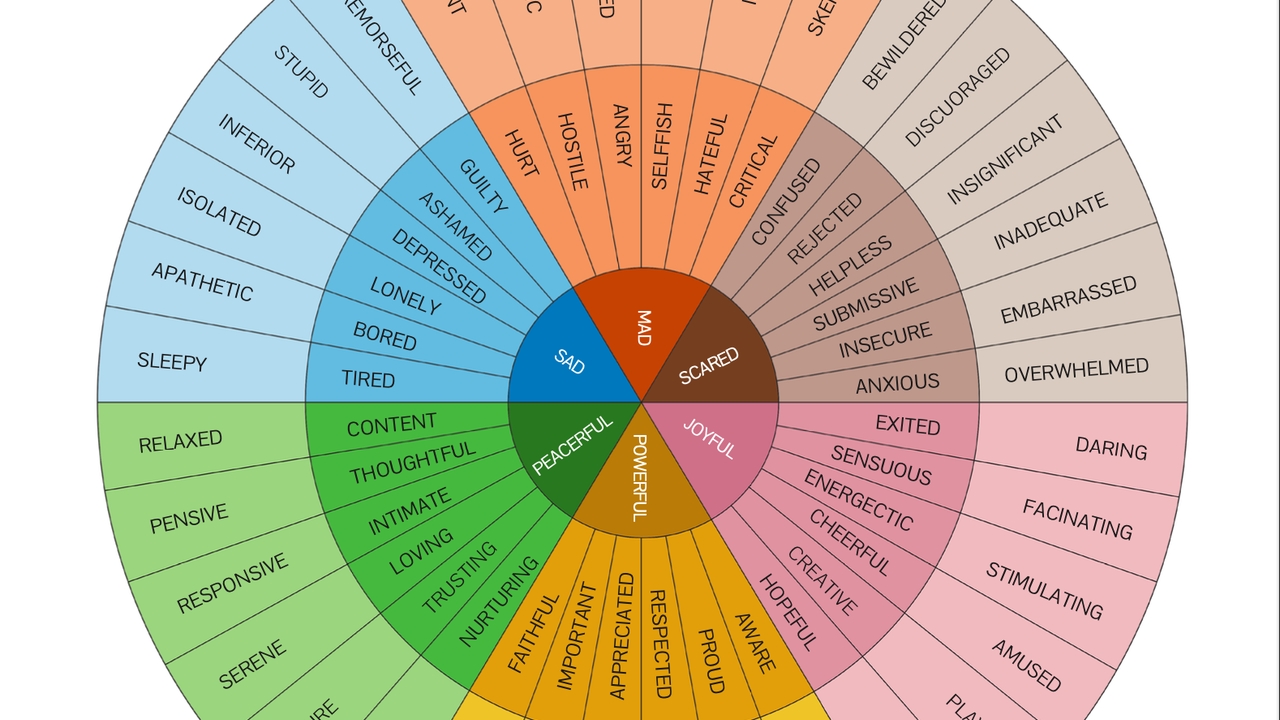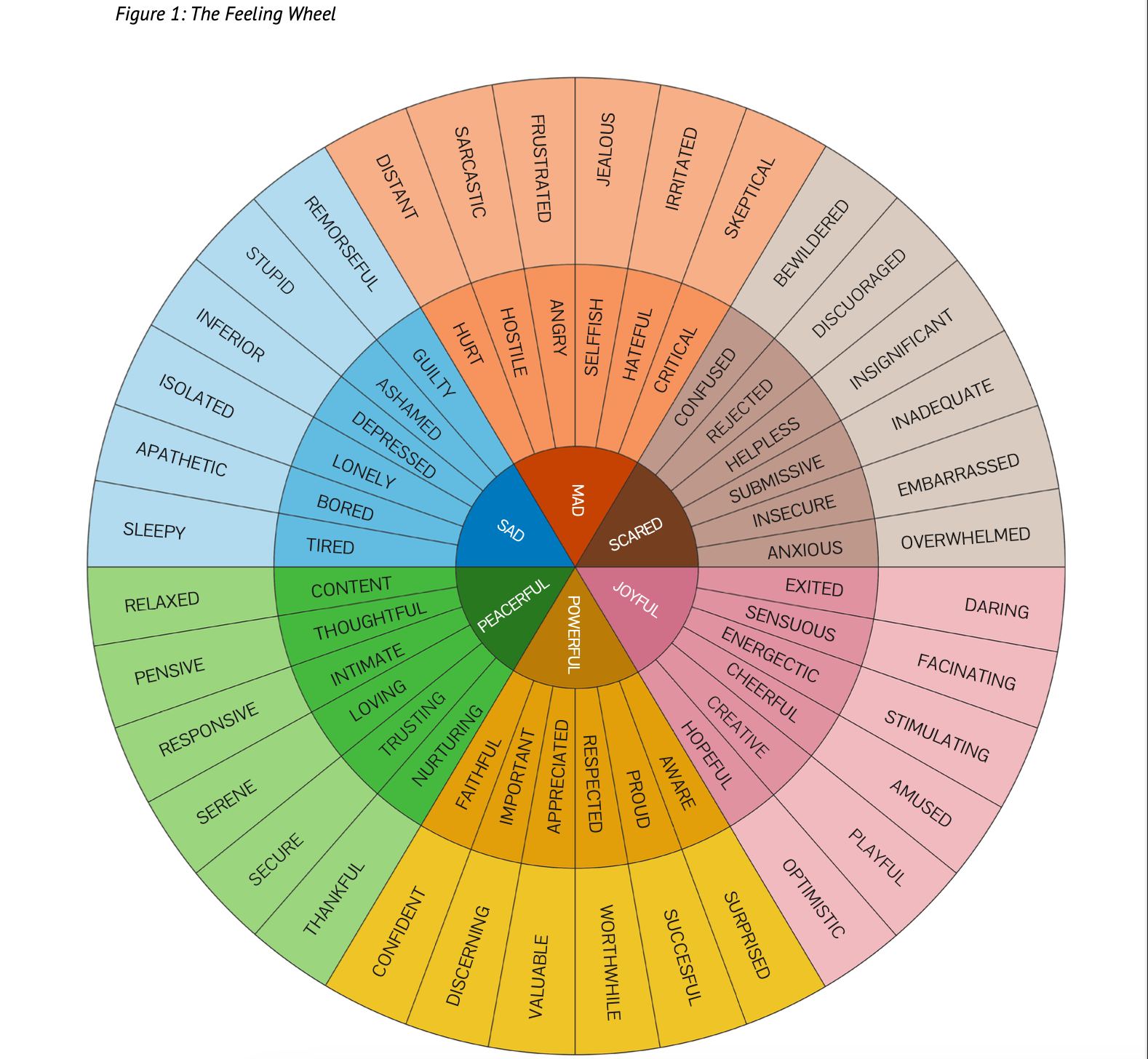The Feeling Wheel
2023-04-05T15:17:08+00:00

The ability to identify one’s own emotions and those of others is a skill that is related to emotional intelligence (Salovey & Mayer, 1990). People differ in the extent to which they are able to identify the degree of specificity of their experiences. People high in differentiation are able to communicate more detailed emotional experiences on different occasions and use different adjectives to represent different kinds of experiences. They are better able to distinguish the intensity of emotions and use a greater emotion vocabulary. In contrast, people low in differentiation use only a few general emotional states and often struggle to communicate their feelings in specific terms.
Research shows that it is important to be able to label experiences with a high degree of specificity (i.e being able to make fine-grained distinctions). For instance, people high in emotion differentiation have been found less likely to drink excessively when stressed immediately prior to an upcoming drinking episode (Kashdan, Ferssizidis, Collins, & Muraven, 2010; Kashdan, Barrett, & McKnight, 2015) and are less likely to react aggressively against someone who has hurt them (Pond et al., 2012). Moreover, preliminary evidence suggests that training individuals to expand their emotion vocabulary and use it in a flexible way can help to them to regulate their emotions more effectively (Kircanski, Lieberman, & Craske, 2012). The present tool was designed to help clients expand their emotion vocabulary.
Goal
The goal of this tool is to train people to be more detailed in describing their feelings. The exercise can help clients to learn to identify or recognize emotions with more accuracy.
Advice
■ Note that the feelings depicted in the Feeling Wheel (see fig. 1) are not a complete overview of all possible feelings and emotions. Rather, they serve as a guide and starting point that may help clients to describe their experiences.
■ Although this exercise can be used in many ways, using it during the day is preferable because the immediate approach circumvents memory distortions or (inaccurate) cognitive representations of the experiences. If the client chooses to use the wheel during the day, the present tool can be nicely combined with the 3 minute coping exercise, which directs attention inward and facilitates connection with the emotional state one is in.
It can be useful for clients to carry a hardcopy of the Feeling Wheel (see fig. 1) or store a digital image on their phones, so that it can be accessed at any given time.
■ Note that it is possible to experience different emotions at the same time. The emotions and feelings in the wheel are not mutually exclusive, but can exist in many combinations, even positive and negative at the same time.
■ “You cannot heal what you cannot feel”: this tool can also be used when aiming to increase self-compassion. In order to develop self-compassion, it is important to pay attention to the experiences that are present, in order to take appropriate compassionate action. For instance, if a client realized that he or she experiences shame, the kind inner voice that can be cultivated can be focused on the experience of this specific emotion (“It is ok to experience shame; I am a human being and I make mistakes.” “This experience of shame tells me that I can learn from this experience so that I can do it differently next time”. )
■ Note that the negative feelings in the inner band of the wheel are located on the exact opposite side of the wheel than the positive feelings. For instance, the positive core feeling that contrasts with sad is joyful. Although your client may use this information to gain insight in the positive emotions or feelings that are least present and may need further attention (see the tool: positive emotion brainstorm), this feature of the wheel should not be used to replace or avoid emotions. For instance, when a client experiences sadness, it is advisable to allow the sadness to be present rather than to try to replace it with joyful thoughts (see also the tool: acceptance of emotions).
Suggested Readings
Kashdan, T. B., Barrett, L. F., & McKnight, P. E. (2015). Unpacking Emotion Differentiation Transforming Unpleasant Experience by Perceiving Distinctions in Negativity. Current Directions in Psychological Science, 24(1), 10-16.
Kashdan, T. B., Ferssizidis, P., Collins, R. L., & Muraven, M. (2010). Emotion Differentiation as Resilience Against Excessive Alcohol Use An Ecological Momentary Assessment in Underage Social Drinkers. Psychological Science,21(9), 1341-1347.
Kircanski, K., Lieberman, M.D., Craske, M.G. (2012). Feelings into words: contributions of language to exposure therapy. Psychological Science, 23(10), 1086–1091.
Pond Jr, R. S., Kashdan, T. B., DeWall, C. N., Savostyanova, A., Lambert, N. M., & Fincham, F. D. (2012). Emotion differentiation moderates aggressive tendencies in angry people: A daily diary analysis. Emotion, 12(2), 326-337.
Salovey, P., & Mayer, J. D. (1990). Emotional intelligence. Imagination, cognition and personality, 9(3), 185-211.
Willcox, G. (1982). The Feeling Wheel A Tool for Expanding Awareness of Emotions and Increasing Spontaneity and Intimacy. Transactional Analysis Journal, 12(4), 274-276.
Tool Description
Instructions
Please take a look at the wheel on the next page (fig. 1). The wheel organizes 72 feelings into a pie chart of sorts and buckets them into these 6 groups: sad, mad, scared, joyful, powerful, and peaceful.
The wheel can be useful in identifying the specific feelings and emotions you are experiencing at any given moment so that they can be addressed and resolved. For instance, if you experience a general sad feeling, you can use the outer bands of the wheel to figure out what specific kind of sadness you might feel. For example, maybe what you are really experiencing is feeling ignored. Note that the reverse can also happen. For instance, by using the wheel you may realize that feeling inadequate may be rooted in rejection or fear on a deeper level.
Direct reflection
You can use the wheel to explore the emotions you are feeling at any given moment during the day. For instance, after a nice conversation with someone, you notice a general feeling of joy. Using the wheel you may ask yourself; what kind of joy am I experiencing right now? Can this feeling best be described as excitement, creativity, cheerfulness etc.?
Daily reflection
At the end of a day, you can take a moment to contemplate and look at the wheel. What did you experience today? Maybe you felt guilty. Once you find “guilty” on the middle band of the wheel, you can see that the associated core feeling (nearer the centre) is “sad”, and the more specific, nuanced feeling (on the outer band) is “remorseful”. Maybe due to forgetting something you promised to do.
Long-term reflection
The wheel can also be used to explore deeper and longer-term emotions that may be impacting you. For instance, maybe you have been feeling scared over the last several months, since the time you lost your job. By going to the core feeling “scared” on the inner band of the wheel, you can look at the two outer bands for feelings associated with “scared” to try to unveil the more detailed, nuanced emotions you are experiencing. You might conclude that you are more specifically feeling rejected and insecure. This can be an important insight that can help you to take specific action.


